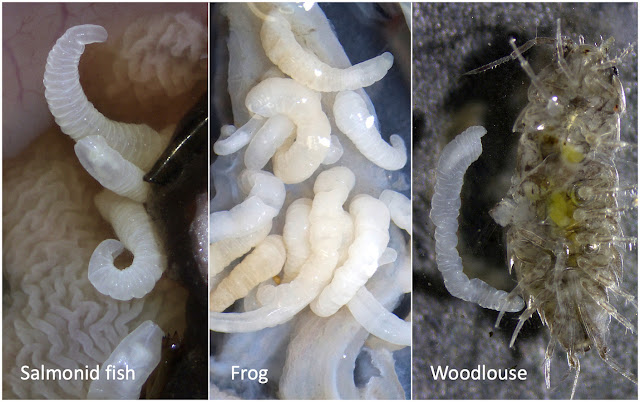Parasites with complex life-cycles often use predator-prey interactions to facilitate their transmission. They have larval stages which infect the body of prey animals, where they wait to be eaten by predators that act as the parasite's final host. But the thing about relying on such interactions to reach their destinations, is that they don't always end up where they are supposed to.
 |
| Left: Adult P. toshimai in a fish's gut, Centre: Adult P. toshimai in a frog's gut, Right: Larval P. toshimai from a woodlouse Photos from the graphical abstract of the paper |
Pseudoacanthocephalus toshimai is a thorny-headed worm which is found in Hokkaidō, in the northern part of Japan. The adult stage of this parasitic worm usually infects amphibians such as the Ezo brown frog and the Ezo salamander, while the larval stage parasitises a species of woodlouse called Ligidium japonicum. While it is primarily an amphibian parasite, P. toshimai is sometimes also found in a range of stream fishes. So how does an amphibian parasite end up in the belly of a fish?
A pair of researchers from Asahikawa Medical University conducted a survey on the prevalence and abundance of P. toshimai at the mountain streams of the Ishikari River around the Kamikawa basin. They caught both fish and amphibians, and examined their guts for the presence of P. toshimai. Of the 174 stream fish that they caught, 56 were infected with P. toshimai, all of them were salmonids and were all from one specific stream. The infected salmonid species included the iwana, Dolly Varden trout, masu salmon, and rainbow trout.
While P. toshimai appears to be fairly common among those salmonids, they were only present in relatively low numbers. On average, each fish was infected with only two or three worms, and none of the female worms carried any eggs. In contrast, the researchers found the parasite to be much more abundant in amphibians. About two-thirds of the salamanders in their sample were infected with P. toshimai, with an average of about four worms per host. Additionally, all the frogs that they examined were infected, with each frog harbouring an average of about five worms. The highest number of worms recorded from a single host was a salamander which had 22 P. toshimai in its gut. Furthermore, all the female worms in those amphibians were brimming with mature eggs, all ready to go.
So while the fish's gut is a hospitable enough environment for the parasite to grow into an adult worm, it is lacking a certain je ne sais quoi that the female worms need to start producing eggs and complete the life-cycle. It is not entirely clear what exactly that might be - it could be that the fish's gut does not produce the right type of nutrients for egg production, or there is simply not enough mating opportunities for the parasite in the gut of a fish - since they are not as commonly nor heavily infected as the amphibians. Either way those salmonids are ultimately dead-end hosts for P. toshimai. So how are the worms ending up in those fish in the first place?
This is where we have to consider the other animal involved in the parasite's life-cycle which is the woodlouse. Woodlice - also known as slaters - are terrestrial crustaceans commonly found under rocks and among leaf litter. As mentioned above, P. toshimai uses a species of woodlouse as intermediate host, where their eggs develop into larval stages known as cystacanths. Since those crustaceans are commonly eaten by frogs and salamanders, they also act as a vehicle to transport the parasite to its final host.
The researchers noticed that P. toshimai is only ever found in fish from one particular stream which is surrounded by bushes. These bushes are habitats for woodlice and amphibians which are the usual hosts for P. toshimai, and provide the necessary conditions for the parasite to complete its life-cycle. But every now and then, instead of getting eaten by a frog or a salamander, an infected woodlouse would fall into the stream, and become a tasty snack for a hungry fish. Indeed, the researchers did find a few woodlice in some of the fishes that they caught.
This study shows that for parasites with complex life-cycles, things don't always work out the way that they are supposed to. Even when all the necessary condition are present and accounted for, once in a while, your intermediate host might get knocked into a stream, and you end up in the belly of a fish.
Reference:
Nakao, M., & Sasaki, M. (2020). Frequent infections of mountain stream fish with the amphibian acanthocephalan, Pseudoacanthocephalus toshimai (Acanthocephala: Echinorhynchidae). Parasitology International 81: 102262.
Nakao, M., & Sasaki, M. (2020). Frequent infections of mountain stream fish with the amphibian acanthocephalan, Pseudoacanthocephalus toshimai (Acanthocephala: Echinorhynchidae). Parasitology International 81: 102262.